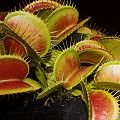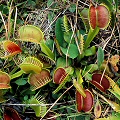Q: Should I transplant my Venus flytrap for other reasons?

Don't repot me!
I'm happy like this!
A:
The short answer is "probably not" while the longer answer
is, "well, maybe but I doubt it." Pretty wishy-washy, eh? Let
me explain why you cannot pin me down on this one.
I doubt your plant is in an ideal situation. (While experienced
carnivorous plant growers sometimes troll these pages, the majority of the FAQ-readers--and right now,
you're one of them--are novices; but I have digressed.)
As I was saying, before I interrupted myself, your plant is probably not in an ideal
situation. For example, the pot may not
be quite big enough to make an award-winning specimen. Or it may look like there are bazillions
of little leaves all crowding each other (especially common for plants recently out of
tissue culture). But such situations
are not all that bad. Since Venus flytraps have small root systems, they
do not need much root room--only several centimeters (a few inches)
of soil will be fine for them. I grow dozens of individual plants, and they are all in little pots
only 5 cm (2 inches) across and 8 cm (3 inches) tall.
So, your plant is probably perfectly happy in its current conditions. Meanwhile, transplanting your
beast into a
new soil mix (while tearing up its root system) may shock it.
Different
people will tell you different things on this point. Some will say repot, others will
say leave your plant alone. In deciding what you will do,
first decide why is it you want to take action.
- You got a new Venus flytrap (your first) and want to give it a big, nice home.
- Do not repot. Your plant is not a new goldfish for your aquarium. It is already living moderately well in its little pot of soil. Do not complicate the process of growing this new plant by transplanting it. If you transplant it poorly, it may quickly die. Proceed cautiously with your first few Venus flytraps. Concentrate on meeting their other requirements.
You don't know if it is in the right soil mix.- Do not repot. The fact that it is still alive means that it is probably in the right soil mix. The nursery grower who potted the plant is probably growing thousands of these plants, and was probably using a good mix. (I am hoping, for the moment, that your plant wasn't field collected.)
You have a green thumb and have an inexplicable urge to repot.- Repot your begonias instead. Venus flytraps do not like to be repotted. Are you sure, for example, you have the right soil? If not, read the FAQ some more, learn about soil mixes, repot your cacti, then (and only then) think about repotting your innocent Venus flytraps.
They are doing really well and are getting big!- Do not repot. Why do you want to mess with a good thing?
It is late summer.- Do not repot. The best time to repot is early spring, just when they are starting to come out of dormancy.
Someone else said they should be repotted- Fine. Don't listen to me. Kill your plants. See if I care.
You have never heard of the Green Swamp, nor do you know why it is related to Venus flytraps- Do not repot. Learn more about Venus flytraps.
You have grown your plant for about two years, and have never repotted.- Hey, you are doing really well! Maybe you should repot. While it is true these plants don't need much root room, a bigger pot will provide more uniform conditions for your plant (i.e. fewer moisture and temperature fluctuations) and it will be happier.

Growing in The Swamp
- You have grown this plant for years, you have learned about the right kind of soil to use, you know all about appropriate temperatures and lighting, and you suspect you may know as much about VFTs as I do but you are just reading the FAQ because it is kind of amusing. Your plant is crowding the pot with numerous side growths on the rhizome. Lastly, you know where the Green Swamp is.
- Do what you think is right.
Page citations: D'Amato, P. 1998a; Rice, B.A. 2006a.